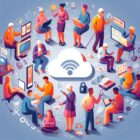Guide to Low-Cost Connectivity Programs for Digital Divide

Did you know that over 3 billion people worldwide lack access to the internet?
If you’re one of them, don’t worry. This guide is here to help you bridge the digital divide.
In this article, we’ll explore various low-cost connectivity programs offered by government initiatives, non-profit organizations, and internet service providers.
We’ll also provide tips for individuals and communities to ensure everyone has access to the online world.
Get ready to connect and thrive!
Key Takeaways
- Disparities in access to technology and internet connectivity hinder educational opportunities and job prospects, impeding social and economic development.
- Government initiatives and programs focus on broadband expansion, digital literacy, subsidized internet access, and device distribution to bridge the digital divide.
- Non-profit organizations and community projects provide community Wi-Fi hotspots, digital literacy programs, and low-cost or free devices to increase connectivity.
- Internet service providers offer low-cost plans like Comcast Internet Essentials, AT&T Access, Cox Connect2Compete, and Spectrum Internet Assist to help individuals access educational resources, job opportunities, healthcare services, and stay connected.
Understanding the Digital Divide
To understand the digital divide, you must recognize the disparities in access to technology and internet connectivity. This divide is the gap between those who’ve easy access to technology and the internet, and those who do not. It’s a critical issue that affects individuals, communities, and societies as a whole. Lack of access to technology and the internet can hinder educational opportunities, limit job prospects, and impede social and economic development.
In today’s digital age, where technology plays a crucial role in almost every aspect of our lives, it’s essential to bridge this divide. Governments, organizations, and individuals are working together to address this issue through various initiatives. Low-cost connectivity programs are being implemented to provide affordable internet access to underserved communities. These programs aim to make technology and the internet accessible to everyone, regardless of their socioeconomic background.
In addition to providing access, efforts are also being made to promote digital literacy and skills training. By equipping individuals with the necessary knowledge and skills, we can empower them to fully utilize the potential of technology. Digital literacy programs can help individuals navigate the digital world, enhance their employability, and improve their overall quality of life.
To truly bridge the digital divide, it’s crucial to address not only the access issue but also the affordability and relevance of technology. By working together and implementing comprehensive solutions, we can ensure that no one is left behind in the digital era.
Government Initiatives and Programs
Governments worldwide have implemented various initiatives and programs to address the digital divide, ensuring that affordable internet access and technology are accessible to underserved communities. These initiatives aim to bridge the gap and provide equal opportunities for all.
Here are some examples of government programs that have been implemented:
- Broadband expansion programs: Governments have launched programs to expand broadband infrastructure in rural and remote areas, enabling high-speed internet access for communities that were previously underserved.
- Digital literacy initiatives: Governments have recognized the importance of digital literacy in closing the digital divide. They’ve implemented programs to provide training and resources to help individuals gain the skills needed to navigate the digital world effectively.
- Subsidized internet access: Some governments have introduced subsidies or discounted internet plans to make it more affordable for low-income households to access the internet.
- Device distribution programs: To ensure that individuals have the necessary tools to access the internet, governments have initiated programs to distribute devices such as laptops or tablets to underserved communities.
These government initiatives and programs are crucial in bridging the digital divide and ensuring that all individuals have equal access to the benefits of the digital age. By addressing issues of affordability, infrastructure, and digital literacy, governments are taking significant steps towards creating a more inclusive and connected society.
Non-Profit Organizations and Community Projects
Non-profit organizations and community projects play a vital role in addressing the digital divide by providing low-cost connectivity programs. These initiatives aim to bridge the gap and ensure that everyone has access to affordable internet services. By leveraging partnerships and funding from various sources, these organizations work tirelessly to provide internet access to underserved communities.
One example of such an organization is ‘Connectivity for All’. They collaborate with local communities to set up community Wi-Fi hotspots, ensuring that individuals who can’t afford traditional internet connections can access the internet for free or at a reduced cost. These Wi-Fi hotspots are strategically placed in areas with limited connectivity, such as rural or low-income neighborhoods. Additionally, they offer digital literacy programs to help individuals maximize the benefits of the internet.
Another notable project is ‘Tech for Good’. This initiative refurbishes and donates used computers to individuals and families in need. By providing low-cost or free devices, they enable individuals to access the internet and take advantage of online resources, education, and employment opportunities.
Non-profit organizations and community projects are essential in closing the digital divide. Their commitment to providing low-cost connectivity programs ensures that individuals from all backgrounds have equal opportunities to thrive in the digital age. Through their efforts, they empower communities and promote inclusivity.
Internet Service Providers Offering Low-Cost Plans
If you’re looking for affordable internet options, consider exploring the low-cost plans offered by various internet service providers. These plans are designed to bridge the digital divide by making internet access more accessible to individuals and communities who may be facing financial constraints.
Here are some key low-cost plans to consider:
- Comcast Internet Essentials: This program offers internet service for $9.95 per month to eligible low-income households. It also provides the option to purchase a low-cost computer and digital literacy training.
- AT&T Access: AT&T offers low-cost internet service for $10 per month to eligible households. The program also includes access to affordable devices, free online training, and discounted Wi-Fi hotspots.
- Cox Connect2Compete: Cox Communications provides internet service for $9.95 per month to eligible families with school-aged children. The program also offers free installation and access to discounted computers.
- Spectrum Internet Assist: Spectrum offers internet service for $14.99 per month to eligible low-income households. The plan includes unlimited internet access and doesn’t require a contract.
By taking advantage of these low-cost plans, individuals and communities can gain access to the internet and all the opportunities it offers. With affordable connectivity, they can access educational resources, job opportunities, healthcare services, and stay connected with loved ones.
Now, let’s explore some tips for individuals and communities to bridge the gap and make the most of the available resources.
Tips for Individuals and Communities to Bridge the Gap
Wondering how you can bridge the gap and make the most of available resources for affordable internet access? Here are some tips for individuals and communities to help you overcome the digital divide.
Firstly, explore low-cost internet plans offered by various service providers. Many companies offer discounted plans specifically designed for low-income individuals and families. Research and compare these plans to find the one that best suits your needs and budget.
Secondly, take advantage of government initiatives and programs aimed at bridging the digital divide. Governments often provide subsidies, grants, or vouchers to help individuals and communities access affordable internet services. Stay informed about these programs and apply for them to reduce your internet expenses.
Another approach is to seek out community resources. Libraries, community centers, and schools often provide free or low-cost internet access. Utilize these facilities to get online, especially if you only need internet occasionally or for specific tasks.
Additionally, consider sharing internet costs with neighbors or community members. Cooperative arrangements, such as sharing the cost of a Wi-Fi connection, can significantly reduce individual expenses while still providing access to high-speed internet.
Lastly, advocate for better connectivity in your area. Engage with local authorities, community organizations, and internet service providers to highlight the need for affordable internet access. By raising awareness and working together, you can help bring about positive change and bridge the digital divide in your community.
Frequently Asked Questions
How Does the Digital Divide Affect Education and Learning Outcomes?
The digital divide affects education and learning outcomes by limiting access to online resources, hindering communication and collaboration, and exacerbating existing inequalities. Low-cost connectivity programs can help bridge this gap and improve educational opportunities for all.
Are There Any Specific Programs or Initiatives Targeting Rural Areas With Limited Connectivity?
Yes, there are specific programs and initiatives targeting rural areas with limited connectivity. These initiatives aim to provide low-cost connectivity options and bridge the digital divide in rural communities, ensuring equal access to educational resources and opportunities.
Can Individuals Apply for Low-Cost Connectivity Programs Even if They Are Not Eligible for Government Assistance?
Yes, individuals can apply for low-cost connectivity programs even if they aren’t eligible for government assistance. These programs aim to bridge the digital divide by offering affordable internet access to anyone in need.
Are There Any Initiatives Aimed at Providing Internet Access to Marginalized Communities or Underserved Populations?
Yes, there are initiatives aimed at providing internet access to marginalized communities or underserved populations. These programs aim to bridge the digital divide by offering low-cost connectivity options and other resources to those in need.
What Are Some Potential Barriers or Challenges Faced by Non-Profit Organizations in Implementing Connectivity Programs?
Some potential barriers or challenges non-profit organizations face in implementing connectivity programs include limited funding, lack of infrastructure, and the need for technical expertise. These obstacles can hinder their ability to reach marginalized communities and bridge the digital divide.



